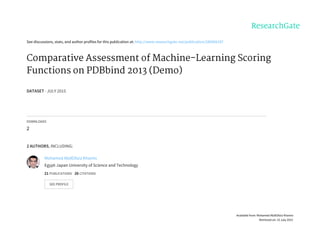
Khamis 2015 - Comparative Assessment of Machine-Learning Scoring Functions on PDBbind 2013
- 2. Mohamed A. Khamis, Walid Gomaa, Comparative assessment of machine-learning scoring functions on PDBbind 2013, Engineering Applications of Artificial Intelligence (2015), http://dx.doi.org/10.1016/j.engappai.2015.06.021 http://dx.doi.org/10.1016/j.engappai.2015.06.021
- 3. Objective http://dx.doi.org/10.1016/j.engappai.2015.06.0212 We present a comparative assessment of machine-learning scoring functions on PDBbind 2013 in computational docking. Computational docking is the process of predicting the best pose (orientation + conformation) of a small molecule (drug candidate) when bound to a target larger receptor molecule (protein) in order to form a stable complex molecule. A scoring function is a mathematical predictive model that produces a score that represents the binding free energy of a binding pose. The result of the docking process is a set of ligands ranked according to their predicted binding scores.
- 4. Powers of Scoring Functions 3 Scoring Power: Score the protein-ligand complex. Ranking Power: Rank different ligands bound to the same target protein. Docking Power: Identify the native binding pose among computer-generated decoys. Screening Power: Classify the true binders versus the negative binders (random molecules). http://dx.doi.org/10.1016/j.engappai.2015.06.021
- 5. Powers of Scoring Functions - Measurements 4 Scoring Power: Pearson linear correlation coefficient between predicted & experimentally determined binding affinities. Ranking Power: Ranking percentage (high-level ranking, low-level ranking, Spearman rank correlation coefficient). Docking Power: Root-mean-square-deviation (RMSD) value between the native binding pose & best-scored binding pose. Screening Power: Total number of true binders among the 1%, 5%, and 10% top-ranked ligands. http://dx.doi.org/10.1016/j.engappai.2015.06.021
- 6. Molecular Features 5 For the scoring and ranking powers, the proposed ML scoring functions depend on wide range of features that entirely characterize the protein- ligand complexes. These features include geometrical features of the RF-Score (Ballester and Mitchell, 2010) (36 features), energy terms of the BALL software (Hildebrandt et al., 2010) (5 features) and energy terms of the X-Score (Wang et al., 2002) (8 features), and pharmacophore features of the SLIDE software (Zavodszky et al., 2002) (59 features). We perform dimensionality reduction using the principal component analysis (PCA) technique. For the docking and screening powers, the proposed ML scoring functions depend on the geometrical features of the RF-Score (Ballester and Mitchell, 2010) (36 features). http://dx.doi.org/10.1016/j.engappai.2015.06.021
- 7. Summary of the scoring functions evaluated in CASF-2013 6 http://dx.doi.org/10.1016/j.engappai.2015.06.021
- 8. Optimal parameters values of the 12 ML scoring functions on the scoring, ranking, docking, and screening powers 7 http://dx.doi.org/10.1016/j.engappai.2015.06.021 Random Forests (RF), Boosted Regression Trees (BRT), K-Nearest Neighbours (kNN), Multivariate Adaptive Regression Splines (MARS), Neural Network (NN), Partial Least Squares Regression (PLSR), Principle Component Regression (PCR), Logistic Regression (LR) , Multiple Linear Regression (MLR), Regression with Regularization (RR), Support Vector Machines (SVM), Decision Tree (DT).
- 9. Performance of the 20 classical scoring functions versus the 12 ML scoring functions with the most important 17 principle components (with @ML suffix) in the scoring power test 8 http://dx.doi.org/10.1016/j.engappai.2015.06.021
- 10. Protein family dependent scoring power of top ML scoring functions 9 http://dx.doi.org/10.1016/j.engappai.2015.06.021
- 11. Effect of changing the number of principal components on the top 5 ML scoring functions scoring power 10 http://dx.doi.org/10.1016/j.engappai.2015.06.021
- 12. Effect of applying the PCA technique on the top 10 ML scoring functions scoring power 11 http://dx.doi.org/10.1016/j.engappai.2015.06.021
- 13. Performance of the 20 classical scoring functions versus the 12 ML scoring functions with the most important 17 principal components (with @ML suffix) in the ranking power test 12 http://dx.doi.org/10.1016/j.engappai.2015.06.021
- 14. Protein family dependent ranking power of the top ML scoring functions 13 http://dx.doi.org/10.1016/j.engappai.2015.06.021
- 15. Effect of changing the number of principal components on the top 5 ML scoring functions high level ranking power 14 http://dx.doi.org/10.1016/j.engappai.2015.06.021
- 16. Effect of changing the number of principal components on the top 5 ML scoring functions low level ranking power 15 http://dx.doi.org/10.1016/j.engappai.2015.06.021
- 17. Effect of applying the PCA technique on the top 10 ML scoring functions ranking power 16 http://dx.doi.org/10.1016/j.engappai.2015.06.021
- 18. Success rates in the docking power test when one or more best-scored ligand binding poses are considered. The cutoff of acceptance here is that the RMSD value between one best- scored binding pose and the true binding pose is lower than 2.0 ˚A. The scoring functions are ranked when the top three best-scored ligand poses are considered to match the native pose. 17 http://dx.doi.org/10.1016/j.engappai.2015.06.021
- 19. Enrichment factors of all 20 scoring functions versus the 12 ML scoring functions in the screening power test. The scoring functions are ranked by their average enrichment factor obtained at the top 1% level. 18 http://dx.doi.org/10.1016/j.engappai.2015.06.021
- 20. Success rates of finding the best ligand molecule of all 20 scoring functions versus the 12 ML scoring functions in the screening power test. Scoring functions are ranked by their success rates obtained at the top 1% level. Numbers in brackets are the number of successful cases, for which the upper limit is 65 (for ML scoring functions the upper limit is 62). 19 http://dx.doi.org/10.1016/j.engappai.2015.06.021
- 21. Conclusion 20 Machine Learning techniques give ability to utilize as many relevant molecular features (e.g., geometric features, pharmacophore features, etc.) as possible. Particularly, ensemble-based machine learning approaches (e.g., random forest, boosted regression trees, etc.) are resilient to over fitting. For docking & screening powers, machine learning techniques need to be more target-specific, train on a larger number of known binders for each target protein, using SVM classifier for discriminating actives from decoys instead of SVR regressor. http://dx.doi.org/10.1016/j.engappai.2015.06.021
- 22. Acknowledgement 21 This work is supported: Mainly by Information Technology Industry Development Agency (ITIDA) under ITAC Program grant number CFP#58 In part by E-JUST Research Fellowship http://dx.doi.org/10.1016/j.engappai.2015.06.021
- 23. Publications 22 Mohamed A. Khamis, Walid Gomaa, Walaa A. Fathy, Machine Learning in Computational Docking, Artificial Intelligence in Medicine, Elsevier, Volume 63, Feb 2015, Pages 135–152. Mohamed A. Khamis, Walid Gomaa, Basem Galal, Deep Learning Competes Random Forest in Computational Docking, Artificial Intelligence in Medicine, Elsevier, 2015 (submitted). http://dx.doi.org/10.1016/j.engappai.2015.06.021
- 24. Supplemental Material & Questions http://dx.doi.org/10.1016/j.engappai.2015.06.02123 Supplemental Material: Source code of machine learning techniques, feature extraction scripts, PDB IDs, and molecular features, etc. https://www.researchgate.net/profile/Mohamed_Khamis4 E-mail: mohamed.khamis@ejust.edu.eg mohamed.abdelaziz.khamis@gmail.com